|
An Airplanes
and Rockets visitor asked me to make good on my offer to scan articles of interest
to visitors - in this case one from the 1973 edition of American Aircraft Modeler
magazine.
Titled, "Uncle Sam's Plastic Air Force," it details the ambitious project the military
undertook to provide visual aids to servicemen to help them identify enemy aircraft
and, equally as important, to identify friendly aircraft. See also
High-School Students Build Plane Models in the March 23, 1942 issue of
Life magazine.
 This private collection of World War II
plastic identification airplane models is owned by the estate of a former Lt.
Commander in the U.S. Navy who was a Class of 1953 U.S. Naval Academy graduate. This private collection of World War II
plastic identification airplane models is owned by the estate of a former Lt.
Commander in the U.S. Navy who was a Class of 1953 U.S. Naval Academy graduate.
Uncle Sam's Plastic Air Force
Black ID models were built by the millions during WWII out of wood, plaster, rubber
or even plastic, by Robert C. MikeshPlastic" was not a household word in 1942. In fact, it was so new that descriptive
words like "hard-rubber," "wood compress," "very hard plaster of Paris" were more
accepted terms to describe the material used to produce thousands of solid plastic
model planes when they first appeared during WW II. A few plastic models preceded
the war, but for the most part, the black recognition models of the war period appear
to have been the start of the most popular form of model planes today."
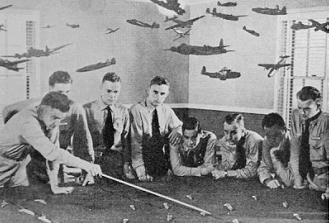

Top: This was the typical method of displaying models for identification
purposes during the war. Navy officers study ship recognition models, too. Above:
When a large number of models or very big planes were to be modeled, a scale one-sixth
of the standard size (1 :72) was created. The smaller scare model is 1 :432, some
of which could be carried in one's pocket for instant reference.
The "Black 10 Models," as they were generally called, were such common items
at military bases all over the world that many servicemen returned home with a few
models of their favorite planes tucked into their duffel bags. Today, despite the
large quantity produced during the war, they are nearly extinct except for a dozen
or more active collections. An unknown number tucked away by individuals have all
but been forgotten.
The models were mainly used for aircraft recognition. Most of them were extremely
accurate in terms of dimensions, shapes and in placement of detail. Placed against
a cloud background and photographed, the models could scarcely be distinguished
from the full-size planes they represented. In fact, they were often used for just
such photographic purposes in the absence of the real enemy planes.
The models were also used for range estimation and combining plane recognition
with gunnery. Gunners had to know not only the appearance of friendly and enemy
planes, but also the size of each so they could tell by the amount of plane seen
in the ring gun sight whether it was within range, how much to lead it, and when
to fire. Since the models were of a common scale of 1: 72 (1 in. equals 6 ft.),
their comparative size could easily be made. A model at 35 ft., for instance, would
be identical to the real airplane seen at just under half a mile - and would look
quite realistic through a gun sight.
Model planes had another supreme advantage over silhouettes in teaching aircraft
recognition. The students could handle them, and therefore were able to study the
plane details more easily. For all practical purposes. they were not handling models,
"but were actually visualizing the real planes . craft of all the major fighting
powers were produced for the government in model form for this purpose. Over 220
types had been issued by the time the war ended - a sizeable fleet in variety by
any standard. Models ranged in size from about six-in. wingspan for average fighters,
to 24 in. for the B-29. They were typically displayed by suspending them from ceilings
for easy viewing in a flying attitude.
The program of model planes for the Armed Forces started the day after Pearl
Harbor. Navy Commander (later Admiral) Louis DeFlorez had just returned from England
where he had seen the British recognition program. This included the use of black
model planes in the 1:72 scale. When students of aircraft recognition handled the
models, they could visualize the real aircraft at every possible engagement angle;
since the models were all black, features - not colors - were emphasized for identifying
friend and foe.
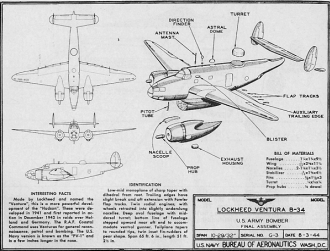 DeFlorez, who had been placed in charge of the Navy Bureau of Aeronautics, Special
Devices Division, brought a few of the models back from England as samples. DeFlorez, who had been placed in charge of the Navy Bureau of Aeronautics, Special
Devices Division, brought a few of the models back from England as samples.
Two men were prominent in helping instigate a program of models for aircraft
recognition purposes - Lieutenants Donald L. Hibbard and Paul A. Garber. Lieut.
Hibbard, later to become Navy Captain, was DeFlorez's Executive Officer and handled
all the administrative matters and procurement details for the model program. Lieut.
Garber came to the Navy at the outbreak of the war from the Smithsonian Institution
where he was the Assistant Curator for Aeronautics. He headed the technical aspect
of this unusual program. Garber, later a Navy Commander, was well-suited for this
post, for he was a well-known educator in aviation, an historian, and model craftsman.
Vast numbers of models were needed quickly. The hand carving of wooden models
would be too time-consuming, although many Ground Training Units put technicians
to work doing just that. Each hand-built model reflected the personality of its
builders, however, and standardization was nearly impossible. A more productive
method had to be devised.
Commander DeFlorez asked that manufacturing representatives make bids on Navy
contracts to produce these precise models. Some of the initially interested bidders
were: Design Center of New York, V. Roxor Short of Clinton, Connecticut, The L.A.
Darling Co. of Coldwater, Michigan, and a firm of display arrangers or makers organized
by George Benckenstein of Cincinnati, Ohio.
All four received contracts because production methods and materials to be used
had not yet been explored and perfected. The story of each recounts many problems
ranging from labor shortages and unfulfilled Navy contracts to legal actions. The
manufacture of molded model planes was a new and very difficult field of endeavor.
Finding a suitable material with which to mold the models and then gearing production
methods to it were the greatest problems. First they tried reinforced plaster compound,
using the technique for forming mannequins. This did not make a perfectly clean
job for mass production - the appearance of the finished plane was apt to be lumpy,
and plaster models shattered when dropped. Since the models were to be sent overseas
and had to stand rough handling in transit (to say nothing of the handling they
would get in actual use). plaster models proved unsatisfactory.
A substance resembling hard rubber followed, but this also proved unsatisfactory
since the wings of the larger models tended to droop. Cast iron as well as Wood's
metal were tried and produced accurate models when the dies were properly cut to
allow for uneven shrinkage. The weight and scarcity of the material were the deterring
factors.
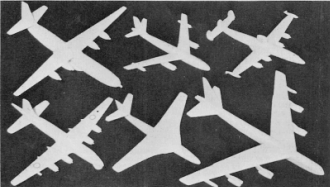
Aircraft with larger than 99 ft. wingspans were modeled in the
special 1:144 scale. Note even "modern" jets are produced - the B-47 and B-52.
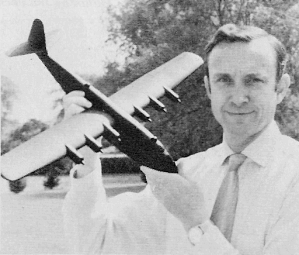
Here the author holds a Bv 222, the largest of all WWII
issued ID models, with a span of 25 inches.
Experiments were made with paper mache, but this substance also failed to have
the desired detail necessary for good models. Some of all types produced, however,
were distributed into the training aid system. process of injection molding of cellulose
acetate plastic was newly developed and had been pioneered by the Cruver Company
of Chicago, (a division of Werner Manufacturing Co.) makers of many automobile plastic
accessories. Model plane war production became top priority for the company, for
their manufacturing method, speed, and plastic material was very satisfactory. Being
a fraction of the weight of die cast metal models, and able to take hard usage,
they could easily be shipped without the danger of breakage. Yet, there was another
important advantage - they could be manufactured rapidly. This was especially important
in the days when the armed forces were anxious to have model planes by the hundreds
of thousands.
A single mold could produce from 35 to 60 model planes an hour compared to a
much smaller production rate for plaster of Paris models. Finer detail could also
be achieved with this plastic. The acetate plastic they used is about the same by
today's standards, but the molding and processing methods have changed considerably.
Among those that have survived over the past 30 years, few show deterioration; only
extensive heat or the sun's ultraviolet rays have any real effect on them.
Before production, an original master model had to be made for each type of plane.
The Comet Engraving Co. and the H&H Specialty Co., both of Chicago, made most
of these masters. The Army now had joined the program with the Navy, and collectively
furnished silhouettes, photographs, dimensions, and occasionally additional sketches
of the original plane. Skilled model makers, accustomed to working with no more
than the clues offered by the photographs and drawings, began to carve the master
models by hand from wood. The completed master models were then sent to specialists
in the Army and Navy for approval. Once accepted, the masters went to Cruver where
dies were made and the planes were ready for production.
The granular plastic was placed in a molding machine and heated, upon which it
assumed a fairly viscous state comparable to the consistency of molasses. The material
was then forced into the die at a pressure of about 30 tons per sq. in. - enough
to force the slow-flowing material into every crevice and groove of the die.
The die was then cooled in water. The time of cooling varied with the temperature,
humidity, and the size of the model plane. (A fighter-size model took about 45 sec.)
Although the models could be made in automatic machines, they usually were taken
from the die by hand and immersed in water to cool and harden further.
The rough models were then cleaned. The gate through which the plastic entered
was cut off, the parting lines cleaned and sanded. The model was complete, except
for painting. Large quantities of carbon black were molded in with most of the plastic
used; this caused the cast plastic to be shiny, and details to be lost in the highlights.
The planes were therefore given a coat of matte flat lacquer.
Finally, they were packed individually in boxes designed for each size model.
The more complicated models were fastened to the carton so they would be less likely
to shift and be damaged in transit.
Because of size or design complications, several types of models had to be assembled.
Large planes, such as bombers and transports, were made hollow which required them
to be manufactured in more than one piece. Other planes, such as the Martin Mariner,
had several struts, floats and twin tails which all had to be hand assembled. All
biplanes, especially those with floats to be added, presented major assembly problems
as opposed to the single one-piece fighter types.
Just as in the actual aircraft industry, where a type manufacturer had to farm
out subassemblies to other companies in order to meet production schedules, Cruver
also resorted to this solution. For the construction of the Consolidated Coronado
four-engine flying boat, for example, the wing was cast by one company, the twin-tail
by another, and the model then assembled by Cruver with the parts that they produced.
As the war progressed, several companies, such as Design Center and Leominster,
became involved in the ID model production.
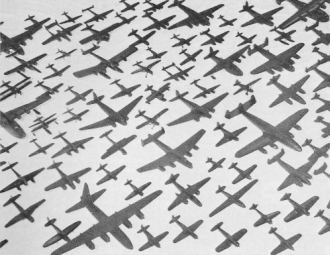
Above: This is part of the Smithsonian Institution's collection
in Washington, D.C. How many can you identify?
Embossed on the bottom of each model from the mold was the name or type of aircraft,
the nationality which it served, and the issue date. If a modification was made
to the mold, the date would be changed. In the case of the postwar models, when
a new production run was made, the current date was generally added. A trademark
identifying the manufacturer was also included. Secretary of the Navy Frank Knox
re-quested that high school students join in the construction of "recognition models"
to be carved out of wood. It was hoped that these wooden models could be delivered
to the armed forces quickly while the plastic model program was getting off to a
shaky start. The youngsters of America, the actual producers of the wooden models,
needed little prompting to get started on this important project. It gave them the
feeling of contribution to the war effort.
DeFlorez, by now the Commander of the Training Division of the Navy, was the
originator of the idea of school-built models. The Navy agreed to sponsor the program
and defray the cost, and to be responsible for the selection of types and the accuracy
of drawings supplied. The Office of Education distributed the plans and instructions
through State Representatives. The construction of models and the inspection took
place at the local schools, generally within the Industrial Arts program; the Navy
provided collection centers and distributed the models.
This was a nationwide program and thousands of youngsters participated. Heaviest
concentration for organized production was in the metropolitan areas, where actual
production lines were sometimes established. By the end of the school year 1942,
hundreds of thousands of models had been delivered. Many students continued to work
through vacation, attending classes at summer school or making the models in their
home shops or community workrooms.
A well-planned model construction method was developed to suit this program.
For each aircraft type selected, a complete set of full-size templates was produced.
Each plan was illustrated in a pictorial view giving a description of the plane,
name of the parts, and a small three-view drawing. Most of these were drawn by Sob
Reeder of the Comet Model Airplane and Supply Co., later to join the Monogram Model
Co. Comet produced wooden kits for these ID models ranging in price from 15 to 35
cents. Other companies followed with improved kits, and the 1: 72 scale be-came
a standard size for the model building profession.
Today the packets of templates and instructions for making the models are collector's
items. Packet "A" and "B" series each consisted of 20 mixed nationality aircraft
types, and "C" series had only ten. Because of the enthusiastic support within the
schools, 300,000 more models were requested for the fol-lowing school year. Template
packet "D," "E" and "F" of ten types each produced 30 new wooden models to be handcrafted.
The program terminated on a nationwide basis in the spring of 1943 and the "G" series,
though printed, was not distributed.
 "Plastic"
was not a household word during WWII. It was something novel. Here an early modeling
machine produces the Savoia Marchetti SM 84. Method is crude by today's standards.
The form of recognition models went beyond the 1:72 scale plastic and wooden types,
however. Since these were space consuming and sometimes awkward to handle, a series
of models one-sixth this size, or 1:432 in scale, were manufactured. Though diminutive
in size and detail. the three-dimensional effect was retained. These were cast in
both metal and injection-molded plastic by several companies. The more popular metal
issues by Comet Metal Products Co., Inc. were painted in more appropriate colors
instead of the flat black of the larger models.
Shortly after the war Kix Cereal offered various sets of four plastic types for
a box top and a given amount in coin. Today, one manufacturer is reissuing a number
of types in the 1 :432 scale series from the wartime molds.
Another type of obscure recognition model was in the form of cardboard press-outs.
These were stamp-cut silhouettes of the aircraft's major components to be fitted
together by the trainee. When assembled, they were accurate 1;72 scale models in
plan and side view, but otherwise quite crude in appearance. To while away endless
hours while on ship, GIs would press out and assemble these models. In so doing,
recognition features were memorized. It is hard to envision, however, combat-seasoned
troops pressing toward
As WW II came to a close, so did the need for the identification models within
the military services. The program was all but abandoned until the military buildup
during the Korean War. Once again the U.S. Government ordered molded models of planes
used in this conflict. But being a confined war and not worldwide as before, production
quantities were kept relatively low.
Changes in general appearance of 10 models in production took place around this
time. The typical black models were replaced by planes with a light gray finish;
in addition, canopies on models were cast in clear material which greatly added
to their realism. Some models were cast in a blue plastic, typical of Naval aircraft
color at that time. The quality of plastic used had improved over the years, cellulose
acetate butyrate being a later type.
Postwar aircraft progressively increased in size, and so did the models. The
8·36, for example, was a gigantic, heavy model built to the 1: 72 scale with a wingspan
of 38 in. Consequently. a newer scale of 1: 144, one half that of the others, was
adopted for aircraft having wingspan in excess of 99 ft. This proved a more practical
size for handling, but did have drawbacks in comparing sizes between the two scales.
Continued cutbacks in military spending finally brought an end to production
of the plastic 10 models by 1961. An estimated 425 types or variations of models
of the larger sizes had been manufactured during those 20 years. The total quantity
of models actually cast reached a phenomenal number and can only be approximated
at over one million. Stockpiles of the current types of planes then in use were
retained, but almost unnoticed.
The Air Force was the first to go out of the "model airplane business." Without
the newer types of planes, the remaining models were of little training value. Due
to the cost of storage, and relatively low value of individual models, the warehouses
were ordered to eliminate their stocks. In conjunction with Armed Forces Day in
the early 1960s. every child that entered a base (Hill AFB in Utah, primarily) where
these training devices were on hand, was given a model airplane. That ended the
program for the Air Force. Just recently the dwindling stock retained by the Navy,
the founder of the program, was transferred to its auxiliaries for their use.
Models in collections today have come from a variety of sources. A few actually
came from military salvage after they had served their purpose. As the military
requirements diminished, backlogs by the manufacturers were released to the open
market and were purchased by the general public, from hobby shops. The largest distributor
was Distinctive Miniatures, of Newark. New Jersey; Polk's of New York was the largest
dealer. For commercial use. 10 models were called Aristo-Craft. but the term didn't
stick. Their prices ranged from $1.50 to $8, depending on the size and complexity
of the model.
It is the postwar "grays" that are the least common in collections. This is due
to the fewer number produced. Today some builders of plastic models paint and use
the ID model as a filler in collections when a shell kit is not available. Often
these are the rare types, but they often flood the collectors' circle when a shell
kit is introduced.
Despite the large quantities of ID models issued. and the efforts by collectors
to obtain various types, several models produced by the hundreds cannot be found.
In many cases only one or two of a kind have been located. Although these are naturally
valued very highly, the sincere collectors prefer model exchanges among themselves,
rather than selling for money.
The search will go on for the missing or rare types. Perhaps the boy of long
ago that was given one of these tokens of the war, or the crew member that kept
one as a souvenir, unknowingly has one of these rare models. All are of interest
to the ID model collector. What do you have tucked away in your attic?
Posted May 10, 2021
|